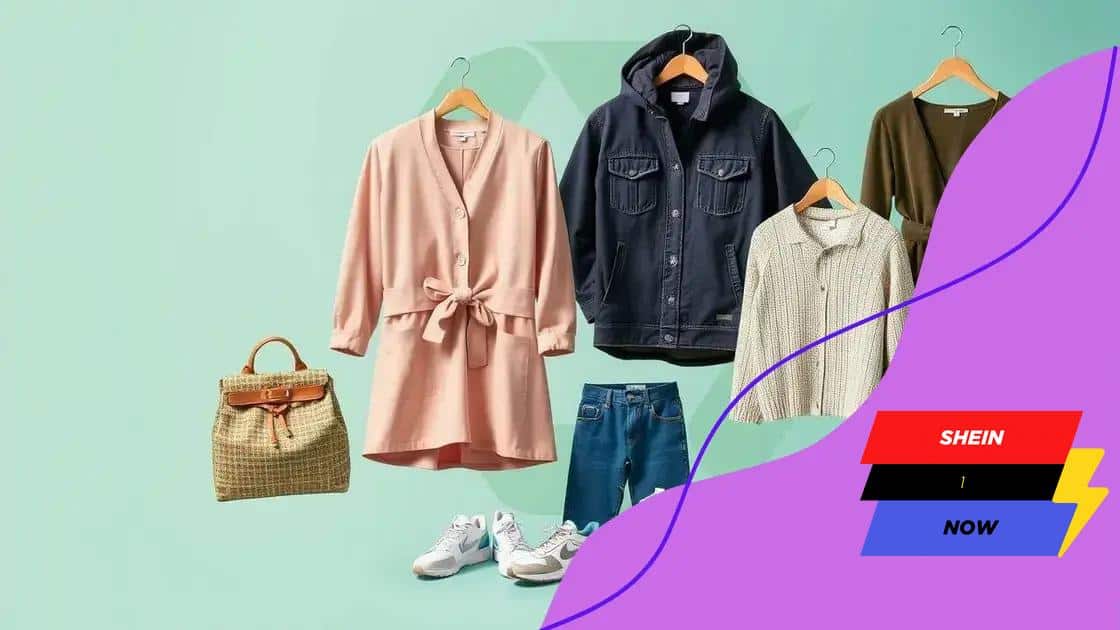Shein’s role in the digital fashion revolution

Shein’s role in the digital fashion revolution lies in its fast production cycles, data-driven decision making, and commitment to sustainability, making fashion accessible and trend-focused for consumers worldwide.
Shein’s role in the digital fashion revolution is undeniable. But what exactly makes this brand a game-changer? As we dive into its strategies and innovations, let’s explore how it’s changing the shopping landscape.
Understanding Shein’s business model
Shein’s business model is intriguing and has helped it become a leader in the fast-fashion world. By understanding it, we can see why the brand is so popular among shoppers. The brand focuses on affordability and trendiness to attract a young audience eager for the latest styles.
Direct-to-Consumer Approach
One of the key aspects of Shein’s model is its direct-to-consumer strategy. This means that the company sells products directly to buyers without going through retailers. This method not only reduces costs but also allows for quicker turnaround times on new styles.
Rapid Production Cycle
Shein operates on a remarkably fast production cycle. They can bring new designs from the drawing board to the online store in a matter of weeks. This speed is essential in the fashion industry where trends change rapidly.
- Fast design to shelf time
- Responsive to market trends
- Frequent updates to product lines
In addition to this, Shein uses data analytics to track consumer preferences and shopping behaviors. By analyzing data from their website and social media platforms, they can identify which products are likely to be successful.
Affordable Pricing Strategy
Another crucial element of Shein’s business model is its pricing strategy. The company offers stylish clothing at very competitive prices, making it appealing to budget-conscious shoppers. By keeping costs low, Shein is able to attract a broader audience.
- Regular discounts and sales
- Strategic marketing campaigns
- Collaborations with influencers
Overall, Shein’s business model revolves around making fashion accessible to everyone. By focusing on quick production, low prices, and utilizing data efficiently, they have reshaped the shopping experience for many consumers.
The impact of Shein on consumer behavior
The impact of Shein on consumer behavior is profound. As a leader in the fast-fashion industry, Shein has changed how people shop and think about clothing. Consumers are now more focused on affordability and trendiness, pushing brands to adapt quickly.
Changing Perception of Fashion
Shein has also influenced how consumers perceive fashion. It emphasizes that style doesn’t need to be expensive. Many shoppers now look for trendy clothes at lower prices, making it easier for them to refresh their wardrobes frequently.
Shopping Patterns Shift
The convenience of online shopping through Shein has altered traditional shopping patterns. Customers prefer purchasing through mobile apps and websites rather than physical stores. This shift has made it essential for brands to create seamless online experiences.
- Increased online shopping traffic
- Preference for quick deliveries
- Desire for user-friendly websites
Social media plays a big role in Shein’s influence. Many consumers discover new styles through platforms like Instagram and TikTok. Influencers showcase Shein outfits, creating a desire for similar items among their followers.
Fast Fashion’s Drawbacks
While Shein’s impact is significant, it also raises concerns about sustainability. Many consumers are becoming aware of the environmental implications of fast fashion. They are starting to question where their clothes come from and how they are made.
- Increased interest in sustainable fashion
- Consumer activism around ethical practices
- Demand for transparency in supply chains
Overall, Shein has reshaped consumer behavior by making fashion accessible, influencing shopping habits, and sparking conversations around sustainability. These changes have made consumers think differently about the clothes they buy.
Sustainable practices in Shein’s strategy

Sustainable practices in Shein’s strategy are becoming increasingly important as consumers demand more ethical options in fashion. As a fast-fashion giant, Shein faces scrutiny about its environmental impact. However, the company is working to implement changes to address these concerns.
Eco-Friendly Materials
Shein has started using eco-friendly materials in some of its products. This shift shows a commitment to reducing the environmental footprint of clothing. By integrating sustainable fabrics, Shein moves towards better practices without sacrificing style.
Recycling Initiatives
Another strategy is the promotion of recycling initiatives. Shein encourages customers to recycle their old clothes. This is part of their effort to reduce waste in the fashion industry. Engaging customers in recycling creates awareness about their clothing consumption and its impact.
- Programs for garment donation
- Incentives for recycling
- Educational campaigns on sustainability
Furthermore, Shein is exploring ways to improve energy efficiency in their distribution centers. By utilizing more energy-efficient technologies, the company aims to decrease its overall carbon emissions. These improvements are steps in a larger effort to promote sustainability while maintaining affordable prices.
Transparency and Reporting
Transparency in operations is vital for Shein. They are beginning to report on their sustainability efforts, highlighting progress in reducing waste and using sustainable practices. This transparency can help build trust with consumers who want to know more about the brands they support.
- Annual sustainability reports
- Information on sustainable sourcing
- Updates on waste reduction goals
In summary, while Shein operates in the fast-fashion space, it is taking strides to incorporate sustainable practices into its strategy. This evolution reflects a growing awareness of environmental issues and a response to consumer demand for ethical fashion.
Technological innovations by Shein
Technological innovations by Shein play a critical role in its success in the fast-fashion industry. By leveraging advanced technology, Shein improves shopping experiences and streamlines operations. These innovations are designed to meet consumer needs rapidly and effectively.
Data-Driven Decision Making
One significant innovation is the use of data analytics to inform business decisions. Shein analyzes consumer behaviors and preferences to understand what styles are popular. This data helps them create designs that align with current trends. Utilizing data allows Shein to be more responsive to the market.
AI-Powered Design Tools
Shein utilizes artificial intelligence in its design process. AI tools can analyze vast amounts of data to predict upcoming trends. This approach enables Shein to introduce new styles to the market faster than traditional fashion brands.
- Identifying consumer preferences
- Creating designs based on trending searches
- Optimizing inventory based on demand
Additionally, Shein employs virtual fitting rooms to enhance the shopping experience. By allowing customers to see how clothes fit without trying them on physically, Shein reduces the return rate. This technology increases customer satisfaction, leading to repeat purchases.
Efficient Supply Chain Management
Technological innovations extend to supply chain management as well. Shein uses advanced logistics technology to track inventory and shipments effectively. This efficiency helps them optimize delivery times and manage stock levels effectively.
- Real-time inventory tracking
- Fast and reliable shipping processes
- Global distribution centers for quicker delivery
In summary, Shein’s commitment to leveraging technology allows it to adapt to market changes swiftly and improve customer engagement. These innovations reflect the brand’s focus on enhancing the overall shopping experience.
Future trends in digital fashion with Shein
Future trends in digital fashion with Shein indicate a shift towards more personalized and tech-driven shopping experiences. As fashion continues to evolve, Shein is at the forefront, adopting new technologies to meet consumer demands.
Increased Personalization
One major trend is the move towards personalization. Shein is likely to use AI to customize shopping experiences based on individual preferences. This includes tailored recommendations and unique shopping environments catered to each user.
Augmented Reality Shopping
Augmented reality (AR) is set to play a significant role in the future of digital fashion. Shein may implement AR features to allow customers to virtually try on clothing. This innovation can help reduce return rates and enhance customer satisfaction.
- Virtual fitting rooms
- Enhanced product visualization
- Interactive shopping experiences
Moreover, Shein will likely continue to leverage data analytics to gain insights into fashion trends. By understanding consumer behavior, they can anticipate what styles will resonate with shoppers. This forward-thinking approach will help keep the brand relevant in a fast-changing market.
Sustainability in Digital Fashion
An increasing awareness of sustainability will influence future trends as well. Shein is expected to adopt more eco-friendly practices and materials in its offerings. This initiative will not only meet consumer demand but also promote responsible shopping.
- Use of recycled materials
- Eco-conscious product lines
- Transparency in sourcing
As Shein navigates the future of digital fashion, it will likely prioritize not just speed and style, but also sustainability. This approach will reflect the growing expectations consumers have for brands to act responsibly while delivering the latest trends.
FAQ – Frequently Asked Questions about Shein’s Digital Fashion
What sustainable practices is Shein implementing?
Shein is focusing on eco-friendly materials, promoting recycling initiatives, and improving transparency in its supply chains.
How does Shein personalize the shopping experience?
Shein uses AI and data analytics to tailor product recommendations and create a unique shopping environment for each customer.
What technology does Shein employ to enhance shopping?
Shein utilizes augmented reality for virtual fitting rooms and advanced logistics technology for efficient supply chain management.
What trends can we expect from Shein in the future?
Future trends include increased personalization, sustainability efforts, and continued use of technology to enhance the shopping experience.





